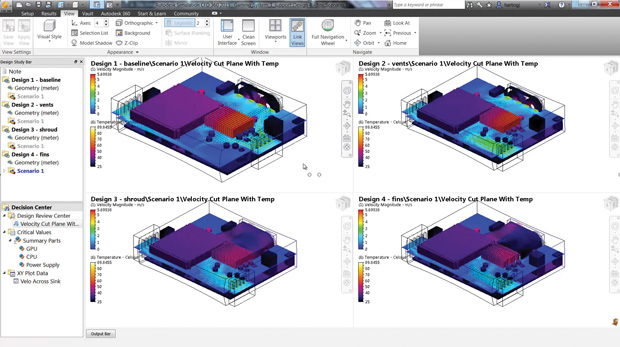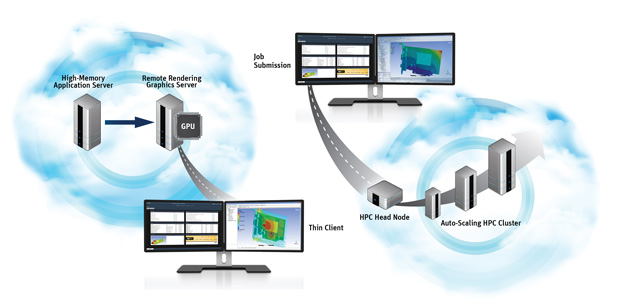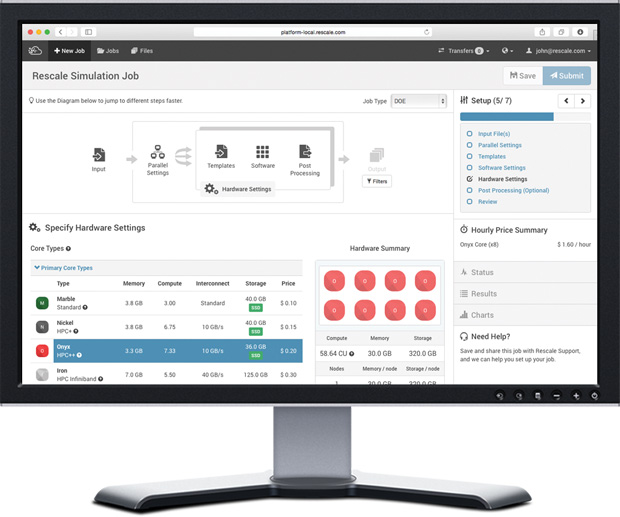
When Autodesk cloud-based simulations are completed, the results are available for comparison within the same interface. The Decision Center allows users to view and compare results simultaneously. Image courtesy of Autodesk.
Latest News
September 1, 2015
 The ANSYS Cloud supports remote rendering, delivering 3D graphics performance and large memory resources. Cloud HPC power is auto-scaled on-demand, assigning machine configurations optimized for specific workloads. Image courtesy of ANSYS.
The ANSYS Cloud supports remote rendering, delivering 3D graphics performance and large memory resources. Cloud HPC power is auto-scaled on-demand, assigning machine configurations optimized for specific workloads. Image courtesy of ANSYS.If you’ve ever submitted a batch job to a remote computer across a building or across the country, you’ve worked with a variation of cloud computing. Shared hardware has made sense for more than 50 years and it still does; we have moved well past the why and onto exploring the how, but sometimes the “how” can seem dull. Is the decision now more like choosing between cable or dish TV? Are cloud resources just repackaging or is there really value added? What are the different business models for accessing high-performance computing (HPC) resources, specifically for intensive engineering simulation projects?
DE has been following the evolution (or full-circle trip) of remote computing almost since the founding of the magazine; coverage ranges from “FEA (finite element analysis) Over the Web” DE March 2001 to “Cloud-Based Analysis: Silver Lining or White Fluff?”. Here we explore some possibly surprising approaches to mechanical and fluid simulations on-cloud.
Cloud Computing by the Hour, By the Core, and More
Large models and detailed analyses can tie up multiple in-house cores for hours or days. Companies are running more simulations than ever, design teams are spread across the globe, and manufacturing groups need timely access to the latest data. All these factors are driving software vendors, cloud managers and third-party groups to offer cloud-based resources with different perspectives on licensing and accessibility.
CD-adapco, developer of STAR-CCM+ and other CFD (computational fluid dynamics) and mechanical simulation software, has been working for years on a strategy to revolutionize the way users access its resources. The company’s flexible Power on Demand (PoD) plan, introduced in 2010, was originally targeted to small- and medium-sized businesses (SMBs) that couldn’t otherwise afford a traditional license. “In fact,” [the first use] was by big companies who had a certain configuration for their daily activities but sometimes needed burst capacity,” says Bill Clark, executive vice president, CD-adapco.
Gradually the method migrated down to other users such as consultants who found the capability helpful for planning client billing and controlling costs. Customers may still set up their models locally, but in the first year, they logged 24,000 hours of PoD time; in 2014 this figure increased to 2.1 million hours.
Clark says cloud resources also offer the benefit of running simulations on the newest cores, specifically optimized for STAR-CCM+ calculations. The company’s ultimate objective is for industrial customers to run STAR-CCM+ on petaflop clusters such as the Blue Waters supercomputer.
Dassault Systèmes took its first steps into the cloud with the 2011 launch of its Version 6 open platform. It integrated the company’s software products into the real-time 3DEXPERIENCE with options for on-premise and on-cloud delivery. 3DEXPERIENCE is the company’s hub for its four product groups, divided into functions of 3D modeling, simulation, information intelligence and social/collaborative interactions. Through separate cloud licensing, 3DEXPERIENCE 2015x now offers access to SIMULIA Abaqus multiphysics software.
Many current customers are looking to the cloud as a means to burst beyond their existing compute capacity, while new customers will find a range of benefits such as project collaboration, says Eric Weybrant, research and development product manager, SIMULIA. “3DEXPERIENCE is a Software-as-a-Service (SaaS) offering that combines cloud-based data and license management with a suite of role-based business applications,” he says. Simulation “tokens” offer flexible software deployment access, and a product called 3DPlay Simulation Extension that permits viewing full simulation content for seamless teamwork on premise and on cloud.
Autodesk offered linked, collaborative CAD services as far back as the late ’90s then expanded its global-access philosophy in 2011 with the launch of Autodesk 360. Scott Reese, vice president of Autodesk cloud platforms sees two trends converging to drive more tasks to the cloud: their customers use talent all over the world, and you can no longer separate design from simulation.
 When Autodesk cloud-based simulations are completed, the results are available for comparison within the same interface. The Decision Center allows users to view and compare results simultaneously. Image courtesy of Autodesk.
When Autodesk cloud-based simulations are completed, the results are available for comparison within the same interface. The Decision Center allows users to view and compare results simultaneously. Image courtesy of Autodesk.“There’s a continuum to this process,” says Reese, “and everybody needs access to design information. We’re now putting it out to a broader set of customers.” Autodesk offers two cloud-based project services in its Product Design Suite: Free A360 collaboration software that supports view, search and share functions and paid Advanced Cloud Services that include Autodesk PLM (product lifecycle management) 360 and Fusion 360.
Reese sees a big shift in the way people are accessing software, saying the cloud has really opened this up. “They want to pay for what they use, as they use it,” he says. “We are moving to subscription models where they can pay month-to-month or annually, and, more relevant to simulations, a consumption-based model where you have access to the simulation tools and simply pay for it as you use it with Autodesk ‘cloud credits.’”
The appeal of cloud-enabled resources has clearly been behind several announcements this year from major simulation vendors. ANSYS already has close to 10 years experience with various cloud partners who host and manage ANSYS software on an HPC clusters—one of many cloud solutions is aimed at SMBs. More recently, it created an enterprise-level solution that provides agility to scale depending on business requirements.
Barbara Hutchings, ANSYS director of Strategic Partnerships, is the company’s expert on the Enterprise Cloud. “This is a response to the old way of deployment which is that every guy who needs simulation gets a machine and a license,” she says. “Now, [we’re] moving it off of the desktop and into the data center where everybody can get access to it.
“What makes it complete,” Hutchings says, “is the ability for the user to do the entire process on the cloud: model preparation, pre-processing, meshing, solving with interactive controls, post-processing and data management.” Customers can also move other software into their cloud.
For more than a decade, Altair Engineering customers have been able to access Altair HyperWorks software through pay-per-usage licensing. Now, Altair has extended its cloud product suite to include full cloud simulation resources (HyperWorks Unlimited Virtual Appliance) along with its existing private cloud architecture product (HyperWorks Unlimited Physical Appliance), Simulation Cloud Suite (a complete CAE lifecycle management system operating in the cloud), and just-announced turnkey solutions through Microsoft Azure HPC resources.
Cloud-based simulation is bringing design work to a whole new level according to Ravi Kunju, vice president of strategy and business development at Altair Engineering. In the past, he says, fixed computational resources forced engineers to optimize a model size or limit analyses to just three or four design variations. “Now, it means that engineers can not only solve more problems,” says Kunju, “but can also reformulate the kinds of questions they’re asking, doing design of experiments and varying a whole suite of analyses.” Cloud resources are therefore the perfect vehicle for employing HyperWorks, the company’s multidisciplinary design exploration and optimization product.
Hosted on Amazon Web Services (AWS), a HyperWorks Virtual Appliance compute-cluster of any size can be created in about 10 minutes. Customers can request that resources be optimized for computational work, high memory or graphics. Altair does the setup, supplying a URL, setting up monthly billing, and compiling a list of users. And, third-party software can be added.
Doing end-to-end simulation on HPC resources while staying in the same environment is just what Exa Corporation had in mind when it introduced its IBM-hosted ExaCLOUD. Web-based and scalable, ExaCLOUD lets users access all Exa software products for fluid flow and heat transfer analysis on a pay-per-use or pre-paid basis, without companies having to own local licenses.
“Engineers are beginning to use this as their central environment, more than just to upload batch jobs, run a calculation and download results,” says Kevin Horrigan, ExaCLOUD product manager. “It’s more that they are uploading initial design data, then running through an entire project, submitting dozens or hundreds of runs, until the project is complete.” Settings can be saved from one run to another, and automated.
Horrigan adds that one of the driving factors behind Exa’s end-to-end approach was eliminating moving files back and forth for each run and worrying about storage space, saying their own engineers had been facing that problem.
Because discussion about the evolution of simulation software usually brings up mention of Nastran variations, it’s interesting to note that MSC Software was offering remote simulation compute-resources as far back as 2001, through its Engineering-e.com site. Users with local licenses paid a monthly fee to upload an MSC Nastran analysis run. This service was discontinued but a related Web-based offering began in 2006 with the advent of MSC Software SimManager. This portal, among other functions, lets users automate running thousands of intensive simulations, so it greatly enhances performing design optimization.
More recently, MSC Software has developed its MSC Apex product with cloud use in mind, so stay tuned for the company to expand in this direction.
Third-Party Solutions
Looking to do more than just simulation on the cloud? Check out the following independent SaaS resources that have made a splash online, some with a cloud-based track record longer than many traditional vendors.
Rescale, a Platform-as-a-Service company, has been coming on strong since its founding in 2011. It offers 120+ pre-tested, natively integrated simulation applications and operates through a multi-cloud network comprising public/private clouds and HPC data centers. This is important for enterprise customers who typically procure simulation packages from different software providers, according to Shing Pan, vice president, Marketing and Corporate Development, Rescale.
“For CIOs and IT administrators, Rescale’s ScaleX Enterprise platform provides flexibility to select across a broad variety of hardware specifications, all with no queues,” says Shin. For individuals and SMBs, Rescale’s ScaleX Pro lets them perform simulations either through supported licenses or on demand.
An example of how Rescale partners with software vendors comes from Rob Kaczmarek, director of Marketing for Convergent Science. Since October 2013, “We’ve allowed our customers to ‘point’ their CONVERGE CFD software licenses anywhere they want, including to Rescale,” he says. This option helps users who either own older hardware or don’t have the money in their current budget to buy a regular license.
Ciespace, acquired by ESI Group this past April, is a player whose “On-Demand” offerings include both SaaS products and a cloud-based platform for high performance and 3D graphics intensive applications. The company first developed a browser-based end-to-end CAE workflow for CFD in early 2013, then added a platform-approach integrating multiphysics applications. The initial solution included pay-per-use OpenFOAM technology (open-source software originally developed by OpenCFD Ltd—now owned by ESI Group – with ongoing development by CFD Direct) and customer-uploaded solvers plus tools for geometry preparation, meshing, visualization and collaboration. Now, with ESI’s support, Ciespace has ambitious ideas for the future, including hosting its parent company’s products.
Sanjay Choudhry, ESI Group vice president, cloud business unit, says they will be expanding far beyond just on-demand services. “The first two areas will consist of on-demand compute services with results processing and collaboration for existing customers with on-premise products, and end-to-end SaaS products for various physics types for SMBs,” says Choudhry. The latter is designed to reduce training time, increase collaboration, and increase productivity through complete workflows that can be cloned and rapidly re-used in the cloud.
 Workflow set-up window for performing simulation on Rescale cloud-based HPC resources. The company offers more than 120 natively integrated simulation applications, with options for individual users, SMBs and enterprises. Image courtesy of Rescale.
Workflow set-up window for performing simulation on Rescale cloud-based HPC resources. The company offers more than 120 natively integrated simulation applications, with options for individual users, SMBs and enterprises. Image courtesy of Rescale.A third direction for Ciespace is building vertical solutions in certain markets where codification of best practices into workflow templates will serve as a starting point for fast design re-use by even non-experts.
Taking an open-source approach to cloud simulation is SimScale, a Web-based platform dedicated to making simulation technology more accessible in terms of cost, know-how and infrastructure. Currently available simulation applications include OpenFOAM technology for CFD, CalculiX for mechanical simulation, snappyHexMesh for meshing and ParaViewWeb for visualization. The cloud service, begun in 2013, already has customers in more than 35 countries.
Lastly, UberCloud is a an HPC-on-the-cloud resource that can serve as your simulation-learning and social hangout space, your direct connection to trial-software options or your portal to pay-per-use simulation power. Launched in 2012, this company began as an exploration of roadblocks to cloud computing with crowd-sourced solutions. More than 2,500 companies are now part of the initiative.
Fast, Flexible and Fully Connected
When off-site hardware and software resources are available for pre-processing, meshing, solving, visualization and sharing, simulation productivity takes the proverbial leap. Designers can move beyond verification to optimization, teams can standardize on methodologies, and IT managers can allocate resources when and where needed. Combined with all the licensing possibilities, the cloud offers a win-win for every size engineering group.
More Info
Subscribe to our FREE magazine, FREE email newsletters or both!
Latest News
About the Author
Pamela Waterman worked as Digital Engineering’s contributing editor for two decades. Contact her via .(JavaScript must be enabled to view this email address).
Follow DE





